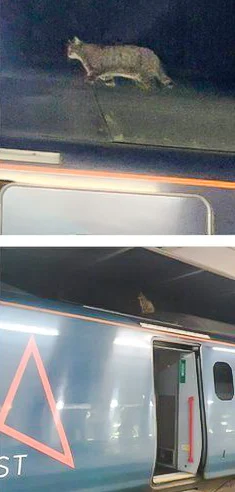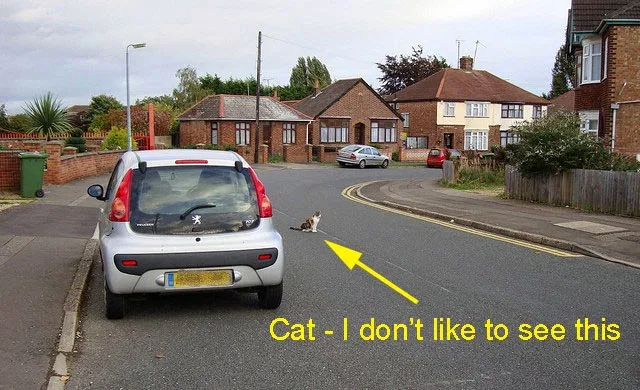 |
| Image: MikeB. The smaller image is from Getty Images. |
Saturday, 30 December 2023
First cat to sail in the Sydney Hobart yacht race
Monday, 30 October 2023
Outdoor cats are 'free cats' which you can take (according to Twitter X user)
 |
| Sophiane who said on Twitter X that outdoor cats are free cats that can be taken. Wrong! |
Tuesday, 3 August 2021
Big Valley council has passed a by-law on cat registration
NEWS AND COMMENT-BIG VALLEY, CANADA: Councillors, the ladies and gentlemen who run the village (which I'm told that it is), have decided to pass a by-law which makes it mandatory to register your cat with the council or some other agency appointed by the council. This is not a world first as far as I am aware but it is very rare indeed to introduce cat registration in line with dog registration.
 |
| Big Valley Council passed a by-law on cat registration. Image: MikeB |
And it is reported that the reason why the council has introduced cat registration is so they can identify the owners of cats which citizens regard as troublesome because, for example, they damage people's property. This can lead to retaliation in which cats are harmed or even killed resulting in police involvement.
They say that concerned residents who don't like to see stray cats wandering around can use traps to contain them and take them, I presume, to a pound or shelter but they still don't know who owns the cat at least initially until they are scanned for a microchip. But sometimes cats aren't microchipped.
The strong argument is that if cats are registered, they will know who owns each cat. The mayor of the village, Clark German, was in favour of the new bylaw because the cats should be under the control of their owner. One councillor said that free range cats help to control the mouse population and that it is the owners who are to blame for any nuisance not the cats.
Despite this counterargument the councillors passed the law. So, there you have it: there will be cat registration in line with dog registration in the village of Big Valley!
Comment: registration of cats without micro-chipping might not work! You can't necessarily identify a cat by their appearance. I would have thought obligatory micro-chipping should go hand in hand with registration. And micro-chipping should be kept up to date because often the details become out of date as the owner moves home. Or the cat belongs to somebody else in due course.
This little story is very typical of much wider issues concerning cat ownership and whether cats should be allowed free access to the outside at their will. It is an ongoing debate in many jurisdictions in Canada, America, Europe, the UK and other countries. Australia probably leads the way in this debate.
As I recall, one Aussie jurisdiction has introduced registration with limited success. Another problem is that you don't know who the cat owners are at the moment. If they don't come forward to register the cats you don't know that they haven't come forward.
This would particularly apply if in response to knowing about this new bylaw some people kept their cats inside for a while. Therefore, the law might be difficult to enforce accurately. It is the same with obligatory micro-chipping. How many people will volunteer their cats to be microchip? And if they don't what does the council do about it?
Monday, 5 April 2021
Rescued shelter cats suited to a barn cat life
The Bangor Daily News has a nice article about barn cats and domestic cats suited to the barn cat lifestyle. It's a reminder to me that some domestic cats like the old-style way of living. And this is the old-style way of living because it's the way people related to domestic cats long ago in the past. It's a question of individual cat personality as some cats are really suited to being left alone to their own devices. All they need is veterinary care, a food source, a warm place to go to when it gets cold and some general interaction with their human caretakers but to relatively low level that are normal.
 |
| Rescued shelter cats suited to a barn cat life. Photo in public domain. |
One rescue centre in Brunswick, USA, Midcoast Humane, have a Barn Buddy programme designed specifically for these types of cats. They are cats who are shy around people and who typically prefer to live outdoors. They going to be happier, this rescue organisation believes, living in a barn or warehouse or in the backyard provided they are given food, freshwater, a place where they are protected from predators and the elements in the snug den to curl up in when it gets cold.
The rescue organisation refers to them as independent and self-sufficient loners and one hopes that they are also experts at catching mice and other rodents. They might need some patience. They certainly need kindness and over time they might learn to trust people more. Perhaps they end up coming into the home in the long term.
The point being made is that these cats, with this particular type of personality, are better suited to this way of life and I think we should remind ourselves that they exist. Perhaps sometimes (and I am guessing of course) they are pigeonholed into a full-blown domestic cat lifestyle which is unsuited to them. This may lead to them failing as a conventional domestic cat which may in turn lead to relinquishment of the cat back to a shelter where they might be euthanised as having behavioural problems.
 |
| Rescued shelter cats suited to a barn cat life. Photo: in public domain. |
Kate McHugh-Westfal of the Midcoast Humane shelter said that: "Cats are versatile workers. There are lots of different options for cats who are much happier being outside or want little or no interaction with humans."
I mentioned domestic cats with particularly independent personalities but of course this group of cats may include feral cats or semi-feral cats. Or perhaps cats who have been deemed to have behavioural problems when brought to the shelter for the first time. They are checked out for being spayed and neutered (and if not they have the op), they are vaccinated and microchipped, ready for their new life as a barn cat.
They are usually at least six months old because the shelter believes that cats younger than this can be socialised and adopted conventionally. McHugh-Westfal believes that kittens and young cats develop their feelings during the first 16 weeks of life. If you can get a feral kitten before then you can develop them to be a good indoor domestic cat.
One aspect of the Barn Buddy program is that it is turning the problem of domestic cat predation on native wildlife species on its head. Lots has been written about how to prevent cats preying on wildlife but in this instance they are working cats whose job is to prey on what humans consider to be vermin and pests. It's a particularly nice solution for that reason.
They recommend that when a barn buddy is first adopted they are placed in a large dog crate where they should live for two weeks. Then once they are let out they recognize the location as home and where their food source is. They also recommend that there should be at least two working cats together at the same time because it helps to prevent them wandering off because they have a friend. The key, they say is that they should have plenty of food and water at all times. The rest, they can deal with themselves.
Another plus for the cats is that they can make friends with other domestic animals such as the horses and livestock. Barn cats and horse go together really well.
These cats are being loved but in a way which is best suited to them, they say. For them, being inside a home would be a bit scary and make them anxious and unhappy. Letting them live outside is the best course of action for them.
I recently wrote about a couple who, because the wife was allergic to cats, were forced to let their domestic cat live outside or his life in the backyard in the garage. It sounds sort of cruel but it actually worked out very well. You can read about that story if you like by clicking here.
Thursday, 4 March 2021
Picture of a cat on top of a Euston train preventing its departure
This is a short story about how cats can disrupt travel. Just this morning I wrote about a feral cat attacking an airline pilot in the cockpit in midflight. The pilot had to return to Khartoum International Airport. The passengers were perhaps bemused and amused at the same time except for the disruption the cat had to their itinerary.
 |
| Picture of a cat on top of a Euston train preventing its departure. Picture: Network Rail. |
In this instance travellers on the 9 pm service from London Euston to Manchester faced disruption because a domestic cat had climbed on top of a high-speed train. The cat refused to budge and it took Network Rail staff 2.5 hours to coax the cat down. It was made more complicated because there were overhead 25,000 volt lines. They had to avoid them both for their sakes and that of the cat.
Eventually they succeeded by pulling a heavy-duty bin towards the carriages, leaving it next to the carriage on which the cat was perched and which encouraged him to jump down. The cat duly disembarked and walked off without thanking his rescuers.
 |
| Tabby cat on top of a train which prevented its departure. Photos: Network Rail. |
Pictures have been released by the government-owned company yesterday showing the cat perched on the driver's cab of the Pendolino operated by Avante West Coast. They are published here.
P.S. The passengers were not delayed for the full 2.5 hours as they were taken off the said train and travelled north on another.
Tuesday, 23 February 2021
Can domestic cats live outside in the winter?
Not sure why the question is being asked by someone because domestic cats are not meant to live outside in the winter! They are not designed to do that. They live with people inside their homes. That said the domestic cat is rugged and enduring but they will be hurt by some winters. It depends on what kind of winter it is which depends on where they are.
- NC kitten rescue: This procedure was used to successfully ‘thaw out’ frostbitten stray kitty
- Siberian cat is the first in the world to be fitted with four titanium prosthetic feet
 |
| Siberian cat lost limbs through frostbite (see link above). Image: PoC. |
Domestic cats are very stoic and enduring. They will put up with very cold weather as the stories testify. But they'll be hurt sometimes and sometimes they will quietly die. We don't see stories about that. How many domestic, stray and feral cats died or were injured by the recent devastating Texas big freeze which claimed the lives of many people because of heating supply problems?
There are no hard and fast rules on whether domestic cats can live outside in the winter. No one's counting and no one has done a study on it. If a domestic cat is forced by unfortunate circumstance to live outside all winter and they live in Canada where it is bloody cold, it is distinctly possible that they will die of hypothermia particularly if their food supply is scarse and they become underfed.
Cats are good survivors but a relentless series of days when the temperature is below freezing will harm and kill domestic cats but it does, as mentioned, depend on the circumstances. In the urban environment there are opportunities to find some warmth and some sustenance.
Kind people feed stray cats. Some make individual shelters for ferals and strays out of cooler boxes for example. Some take the cats in and adopt them. There are food scaps around the place and many unwanted stray domestic cats make their way through cat flaps to 'steal' cat food inside homes. This is common actually. So, yes, when the circumstances are right a domestic cat can live outside in the winter. They'll gradually become feral.
They will lose their health and coiffed appearance. They'll become ragged and sometimes dirty. Their lifespan will be shortened but they might survive.
Thursday, 28 January 2021
Picture of a cat on hiking trip. Is it an unrealistic dream?
I'm asking the simple question whether it is a good idea to take your cat hiking. You put your cat in a backpack and off you go. The picture looks great. You are stimulating your cat to the maximum. Your cat has got used to it and therefore 'behaves'. It has taken some time to achieve this. Because at the beginning your cat wouldn't cooperate.
You tried a lead and she just fell over so it's taken months and months to get her to the position where she cooperates and comes along with you on a hiking trip. But when you go for a walk along a hiking trail she wants to go left and right and stop and sniff. So you make about a mile of progress and consider that to be a great success. Then you go back to your campervan.
 |
| Picture of a domestic cat on a hiking trip. Is it an unrealistic dream that is being sold? Pic in public domain. |
It is a good idea? That's why I have put the question inside the picture. Because it looks really good but we do not know what happens behind the scene? You see some wonderful photographs of cats in beautiful places on Instagram. You might see a cat with a dog and they have been carefully arranged. The background is magnificent with mountains and lakes or a superb forest. A lot of work goes into this photography and the distinct impression is 'great success'.
But is it just a dream that is being sold to people? It's a dream to people who live in the urban environment. Who struggle with day-to-day living. Their cat is a full-time indoor cat because it's unsafe outside. The owners of the cat love their cat and want to do more for them but they struggle to earn a living and therefore are not at home enough.
They worry that their cat is stressed and they want to enrich the life of their cat. The pictures on Instagram of a beautiful Bengal cat in front of a lake switches them on to the possibility that they could give their cat this kind of life.
But, and this is the big but, is it really feasible? Is it too complicated? Is it workable? Is it viable? Are the people who publish these photographs on social media simply doing it as a business to make money and to become influencers? That is probably what is happening but they are inadvertently or deliberately selling a dream. A dream that is probably and possibly unattainable for the vast majority of people. It may be impractical and probably is.
If my assessment is somewhere near correct then I don't think the social media cat hiking picture stories are helpful to people. Because it will lead people into believing that they are a failure in respect of cat caretaking.
Monday, 3 September 2018
Hitting a cat on the road is upsetting to the car driver
 |
| Cat on side of road. |
The last item is rarely discussed. Hitting a cat on the road is very upsetting to a large section of society. Not everyone will care but millions will and through no fault of their own they find themselves in a very difficult position.
The driver is morally obliged to stop the car, check the cat, take the cat to the nearest veterinarian as a matter of urgency, make sure the cat is scanned for a microchip and make sure the vet contacts the cat's owner if she has one. If not there is the added complication of what to do next. Who pays the vet's bills? Do you authorise euthanasia and so on.
And in Britain 99% of cat owners allow this possibility to come about. They don't seem to recognise the dangers and the burden that it might place on a car driver.
I am not saying that letting a cat wander outside is automatically a bad decision because sometimes the outside is safe for a cat but oftentimes it is not because of heavy road traffic nearby.
Cat owners need to think of others, especially drivers of vehicles, as well as the safety of their cat when they let their cat wander freely outside.
Friday, 2 March 2018
Conditions and Diseases Linked to Indoor and Outdoor Cats
Cats confined indoors
- Feline urologic syndrome - disease associated with the lower urinary tract of the cat
- Odontoclastic resorptive lesions - the loss of part of the tooth
- Hyperthyroidism
- Obesity
- Household hazards
- Behavioral problems such as inappropriate elimination
- Boredom
- Inactivity
Cats allowed access to the outside
- Infectious diseases such as parasitic and viral diseases
- Road traffic accidents
- Other accidents such as falling from a tree
- Fights with other cats
- Attacks by humans, dogs and other animals
- Poisoning
- Theft
- Going astray
Sunday, 1 June 2014
Why 80% of Britons Let Their Cats Go Outside
Perhaps the main reason why many more cats in America of full-time indoors is because there are more predators in America who would kill a cat. But it goes beyond that and because there are so many indoor cats in America it is one reason why there is declawing in America because the argument goes that cats don't need their claws if they're indoors all the time.
Using that argument, some Americans might believe that British people don't declaw their cats because they let their cats go outside unsupervised and therefore they realise that they need their claws to defend themselves. This is incorrect.
 |
Cat on UK road. I don't like to see this because I have experienced cats being killed on roads. |
The reason why British people let their cats go outdoors and why nearly all cats in the UK are indoor/outdoor cats is because British cat owners want their cats to live as natural a life as possible and they are prepared to let their cats take the risk of being injured. The biggest risk of being injured in the UK is by a vehicle on the roads.
In the UK, many people don't know what declawing is because they had never heard about it and it does not enter their minds. It is not part of the equation. It's not part of cat caretaking in the UK. Therefore, the declawing of cats has no impact whatsoever on decision-making about any aspect of cat ownership in the UK.
It could be argued that many British people are too sloppy and laissez-faire about letting their cats go outside. I could accept that argument because I believe that if cats in Britain are allowed to go outside they should be supervised or the area where the cat lives should be safe from potential road traffic accidents. That is not always the case.
Whereas a British person might criticise an American person for keeping her cat inside all the time, an American person could be justified in criticising a British person for letting her cat go outside unsupervised where it might be unsafe to do so because a road traffic nearby. Sometimes, a middle ground is probably the best balance between safety and a natural life.
Some Brits have never experienced the loss of a cat on the roads. If they did they would not be so relaxed about letting their cats roam.
There may come a time in Britain when more people follow the American lead and keep their cats inside full-time as the population of the UK increases resulting in more traffic and therefore more risk of injury for a cat.
If you are a Brit you may have a different viewpoint. If so please leave a comment.
Featured Post
i hate cats
i hate cats, no i hate f**k**g cats is what some people say when they dislike cats. But they nearly always don't explain why. It appe...

Popular posts
-
The big Maine Coon cat (MC) is very impressive and the biggest purely domestic cat in the world (I am excluding the wildcat hybrids ) but no...
-
Photo of Nebelung Cat Lovenblues Mozart Bronikowski copyright © Helmi Flick – please respect copyright. The Nebelung has a medi...
-
Russian Blue Kitten photograph by Sensual Shadows Photography Before you go in search of Russian Blue Kittens have a look at these and h...

